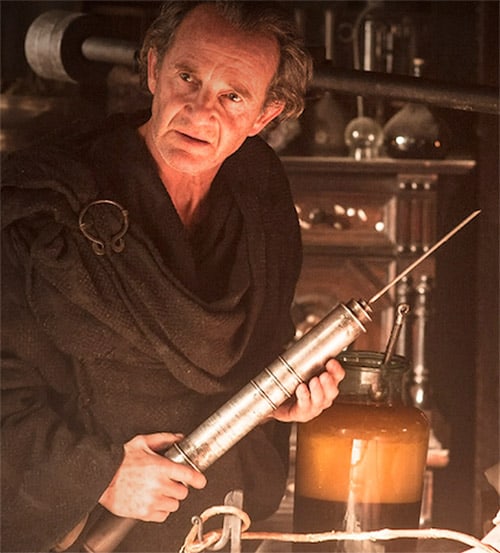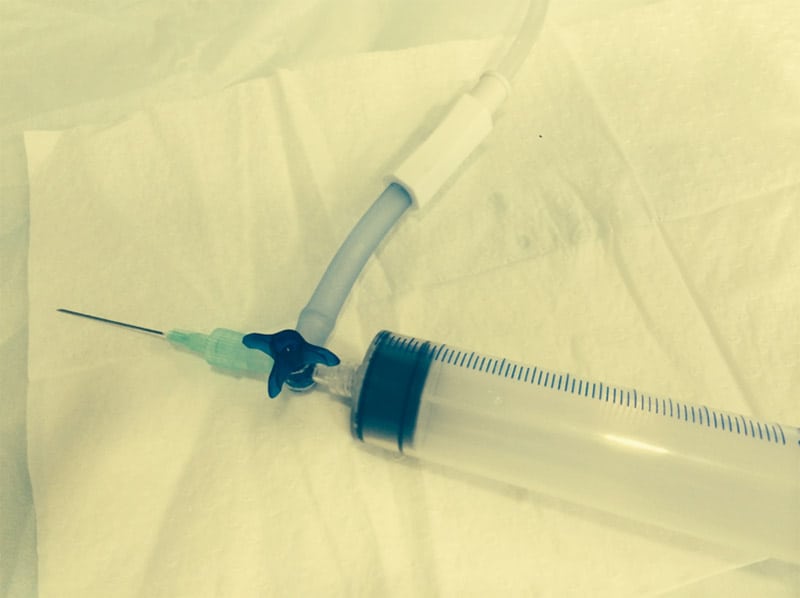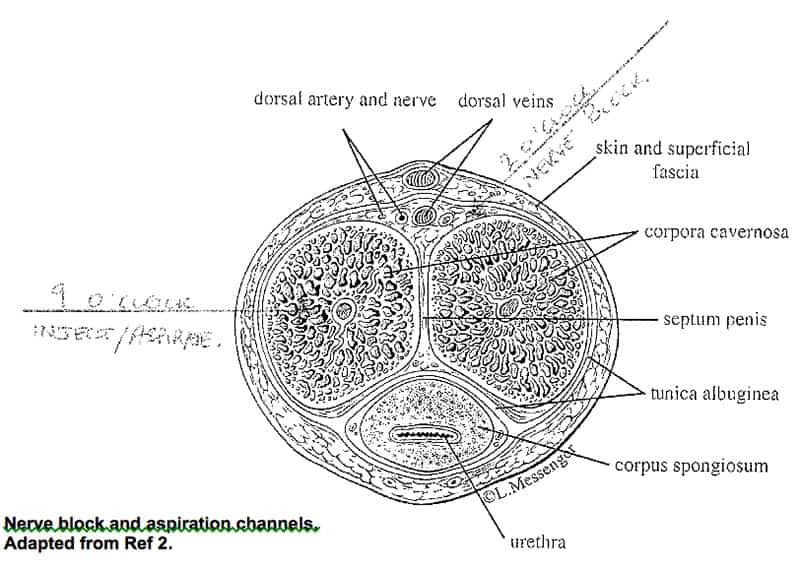 CASE
CASE
A 46 year old man presented to our ED mid morning complaining of a persistent erection since 10pm the night before, when he had injected 20ml of alprostadil (“Caverject”) into his penis. He had not experienced any detumescence, and was quite distressed. We all know the solution to the problem – just drain the corpus cavernosum, right? But how easy is that to do in practice? The last presentation of priapism that I had managed in the ED had gone to theatre, but unfortunately our surgeons were caught by an emergency upstairs.
The ball was back in my court then. (No pun intended.)
TEMPORIZING
There are a large variety of “home remedies” that can be applied to priapism, but none of them are likely to make a difference under these circumstances for our patient. Oral pseudoephedrine can be given as a dose of 60-120mg, but the efficacy is unknown. For a patient with persistent ischaemic priapism of significant duration it’s best to just crack on and fix the problem.
The solution here is procedural – aspiration and injection of a sympathomimmetic agent, specifically phenylephrine. Aspiration alone is thought to fix one quarter to one third of priaptic patients, but with accompanying injection of sympathomimmetic agents the rate of resolution is as high as 80%1.
EQUIPMENT
This is a relatively easy procedure to perform, but it will take about half an hour out of your day, so make sure you’re prepared.
The essential equipment required is very little:
- a 25g needle and 10ml syringe to administer regional anaethesia
- a 23g needle, and phenylephrine diluted as discussed below
- a “draining set”
- a watch
- two pairs of hands
When it comes to setting up a draining set, there a large variety of options and opinions expressed in various blogs. These vary from the easy to find and practical to very sophisticated but hard to source. In general when I am approaching problems in the ED I tend to try to use common equipment that I am familiar with and that is easy to find
My draining set therefore consists of:
- a 21g needle
- a 3 way tap
- a large syringe (30ml plus)
- a kidney dish or bowl for aspirated blood OR a leg bag to allow measurement of any volume aspirated and minimize any mess. (To connect your leg bag to your three way tap you may need a piece of suction tubing to mate the two together. This provides a relatively watertight connection – see the attached picture to illustrate the connection.)
You’ll also need
– a nurse, intern, medical student or other willing assistant
– various sterile drapes, gloves and aqueous chlorhexidine to clean the area.
ANAESTHETIZING THE AREA
Regional anaesthesia provides good relief for the pain about to be inflicted on our poor patient.
Use the 25g needle to infiltrate ~3mm at 2 and 10 o’clock around the base of the penis. Aspirate to ensure you are not in a vascular bed, and raise two large blebs in the area. This should block both dorsal penile nerves, and provide roughly hemispherical analgesia to the penis.
Adjuncts can be used to assist the procedure. We used a nitrous blender set to 60% NO. Procedural sedation could also be used for people hard to reassure or anaesthetize.
I would also recommend you approach the patient with a healthy dose of both sympathy and humour. It’s a sensitive subject. Really!
DILUTING THE PHENYLEPHRINE
Phenylephrine is available in Australian hospitals, but it can be hard to find. It’s an alpha agonist often used in anaesthesia, so if it’s not in your ED, OT is a good place to start looking.
We want to use it to help with vasoconstriction in the corpus. To do this we want to inject 200mcg every 5 minutes until we have achieved detumescence. Phenylephrine comes in vials of 10mg/ml. So, here is how we dilute it down to a useable form…
Solution 1.
Dilute the 1ml of 10mg/ml Phenylephrine from the vial up to 10ml in 0.9% NaCl.
Now we have 10mg/10ml, which is 1mg/ml
Solution 2.
Take 2ml of the above solution 1 (2mg in 2ml) and dilute it up to 20ml in a 20ml syringe with 0.9% NaCl.
Now we have 2mg/20ml, which is 0.1mg/ml or 100mcg/ml.
Injecting 2ml of solution 2 will give us a bolus of 200mcg. Easy really! (The same trick can be used to dilute adrenaline down to 10mcg/ml to administer boluses of 20-50mcg to shocked patients, but that’s another blog post!).
THE PRACTICALITIES
Injecting the Phenylephrine
Place the 21g needle into the corpus at 9 o’clock, and aspirate blood to confirm position. Give the syringe to your assistance (which is why you need a second set of hands), and ask them to inject 2ml (of solution 2, this is 200mcg) every 5 minutes. The needle is left in position in the anaesthetized corpus cavernosum in the intervening 5 minute period. If you think that we’re probably going to have to inject 1-2mg of phenylephrine that’s a lot of injections into a very sensitive area if you withdraw after very hit.
Aspirating
In a lot of ways, this is the easiest bit. Anatomically, the corpus cavernosa communicate through an incomplete midline septum, so aspirating one side of the penis is enough to drain the whole thing properly.
- Take a lateral approach. There are no major structures to get in your way.
- Aspirate to fill your syringe
- turn the 3 way tap to “off” to the penis, and push the contents of the syringe into the waste bag, or waste dish
- Open the 3 way tap to the penis, and repeat step one until detumescence has occurred.
Once you’ve finished, voila! Problem solved, and the patient can be discharged once:
– a urologist has been consulted to arrange follow up
– the patient has passed urine
Dr Luke Lawton
REFERENCES
- American Urological Association, Inc. : 2003. Guideline on the management of priapism. Retrieved 1 October 2014from http://www.auanet.org/common/pdf/education/clinical-guidance/Priapism.pdf
- Padma-Nathan H Medical management of erectile dysfunction: a primary care manual. In Professional Communications Publishers 1999 New York, NY:Professional Communications Publishers












Priapism: How To Treat It. – Resus
awrtenshjtx
[url=http://www.gj252j7a10cd0e320wj8hatehrf95204s.org/]uwrtenshjtx[/url]
wrtenshjtx http://www.gj252j7a10cd0e320wj8hatehrf95204s.org/
Modern Shop Fittings
Chg Chlorhexidine Gluconate
ブランド服コピー痞客邦
Tripod Easel
デュプリケーター自作コピー機おすすめトールケース販売
Freezer Curtain Rolls
Fendiフェンディマフラースーパーコピー
Chanelシャネル財布スーパーコピー
China Lab Washing Machine
LouisVuittonルイヴィトンバッグスーパーコピー
japanese style squat toilet
MCMエムシーエムバッグスーパーコピー
Photovoltaic Battery Storage
Anxi Tie Guan Yin
Gucciグッチマフラー販売店
ブランドブレスレットコピー代引き
Industrial O2 Plant
Plant Blister Packs
Gucciグッチスマホケーススーパーコピー
Growth Promoter
コピー時計
Os&Y Valve
ブランドDiorディオールマフラーコピーN級品
Animal Crossing New Horizons Controller Nintendo Switch Factory
ブランド財布コピー
China 2 Gauge Regulator
ブランド時計コピー
95mm Core Drill
ブランド時計コピー
Canvas Beach Umbrella
ブランド指輪スーパーコピー
moveable toilet
Hublotウブロブランドコピー代引き
Canvas Tote Shopping Bags
Loeweロエベバッグコピー
Sintered Metal Filter Elements
Hublotウブロ時計スーパーコピー
Child Gps Tracking Device
IWCコピー激安
Gucciグッチサングラスコピー
60W LED ZOOM PAR LIGHTS
Cold Chain Boxes Medicine Cooler
Balenciagaバレンシアガ帽子販売店
ブランド財布コピー代引き
Decorative Carriage Bolts For Furniture
Safe Disinfectant Wipes
ブランド財布スーパーコピー
ブランドCelineセリーヌイヤリングコピーN級品
China 27 2k 144hz Ips
Hermesエルメスバッグコピー
Outdoor Protective Products
Chanelシャネルネックレススーパーコピー
Gehl Travel Motor
ブランド時計コピー
Cotton Wrist Band
ブランドGucciグッチスマホケースコピー代引き
Milling Tool
Guangxi Beiliu Wuchang Pigment Co., Ltd.
Hermesエルメスブレスレットコピー
ブランドLouisVuittonルイヴィトンイヤリングコピーN級品
1 Cross Wholesale
Cavity Band Pass Filter
Connectors NBR Wire Seal
ブランド時計コピー
Throttle position sensor for GM
60 Oxygen Mask
コピー時計